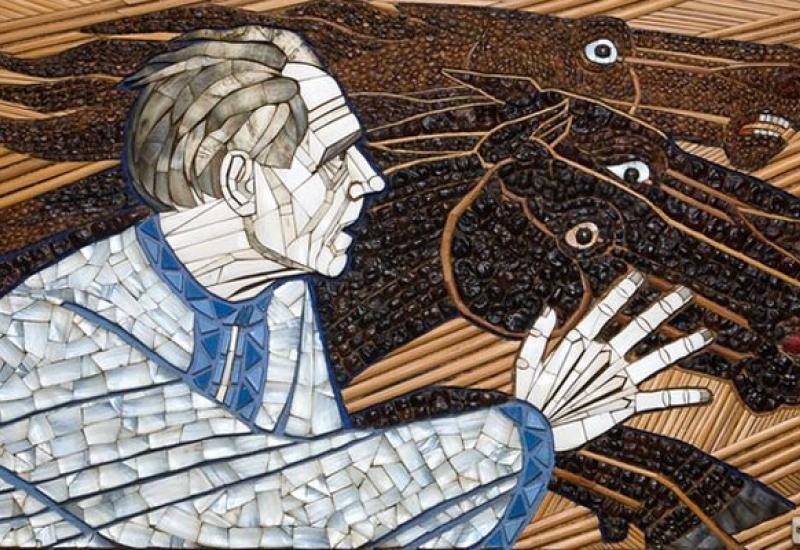"I forever understood and acquired: folk art - the primary source of art forms... It is known very long time ago, it lived, gained strength in the people, in its subsoil. Ethnographic, subject, other signs are yet a nationality. It is a question of thinking system where color acts as an image, about deep the phenomenon of the original artist in a palette".
Synytsia Grygoriy
Synytsia Grygoriy Ivanovych - the artist who outstripped time in the works. He is fated to create the new painting constructed in a coloristic basis, that is on dialectic understanding of unity of opposite colours: cold and warm, dark and light. He invented new monumental equipment and named it - "Floromozayika". His epic picturesque and mosaic compositions astonishes "Yaroslav the Wise", "Nestor the Chronicler", "Babi Yar" and others.
In the world there are no similar mosaics. Probably, it is the truth. The most usual chestnuts, but from them are created a princely dress, the image of a buffalo and horses. Ordinary acorns, cane, fruit stones, nacreous cockleshells. But in hands of the master who allocated esthetic essence of the subject world of the nature, surprising artistic images were born.
It is impossible to ignore monumentalism of works, their historical orientation and patriotism. Titanic labour on works astonishes, therefore mosaics were created for years.
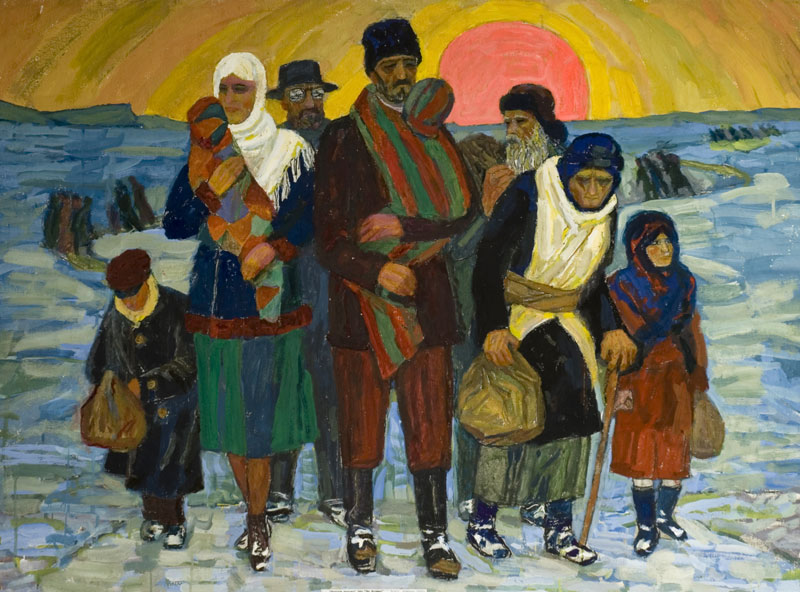
Synytsia Grygoriy Ivanovych not only created fine mosaics, but also a set of works in equipment of a water color and temperature: in landscape and still life genres and in abstraction.
But it happened so that it is difficult to call Synytsia the known artist. Its works are known by rather small circle of fans of art. It is even less of those who up to the end realizes fulfillments of the Master.
Grygoriy Inanovych was born on January 17, 1908 in Odesa in a simple family. In 1914 he suffered a hip ankylosis, then reverse fever. He left hospital with the disabled from childhood (one leg was almost 20 cm shorter due to deformation of the hip of the skeleton). After death of parents relatives transferred the ten-year-old boy to education to one of children's shelters of Elisavetgrada. The serious illness, the hungry and hammered childhood, absence of understanding and support in aspiration to become the artist didn't break him.
He studied in the Kirovograd art and industrial school, then at the Odesa high art school where at once he got to Gershenfeld's talented teacher. The teacher and the pupil had common interests - love to national folk art. Gershenfeld, having found unusual talent, persistence and diligence of the Synitsia, advised to him to enter the Kyiv art institute. Having followed advice, Grygoriy Inanovych got in Kyiv to Nikolay Rakitskogo's workshop - one of talented pupils and colleagues of professor Mikhail Boychuk. Synitsia was taken by ideas of school of Boychuk on revival of the Ukrainian mural which blossoming was at the time of Kyivan Rus'.
And in 1934, the Faculty of painting was declared "a hotbed of formalism" and all students-"bojčukìstam" offered to leave. Synitsia again entered competition for the Institute and studied one year in the workshop of painting Professor Padalky. And in the fall of 1936, Mikhail Boichuk and a number of his closest disciples and associates have been charged with "nationalism", repressed as "enemies of the people" and shot. Students of the Faculty was reduced to two groups. Gregory Synitsia was lucky enough to be among them. However, not wanting to bring the school Michael Boichuk, being a student of the fifth course, Grygoriy leaves the Institute and begins to engage in self-education. That is, in fact, he even had no higher art education.
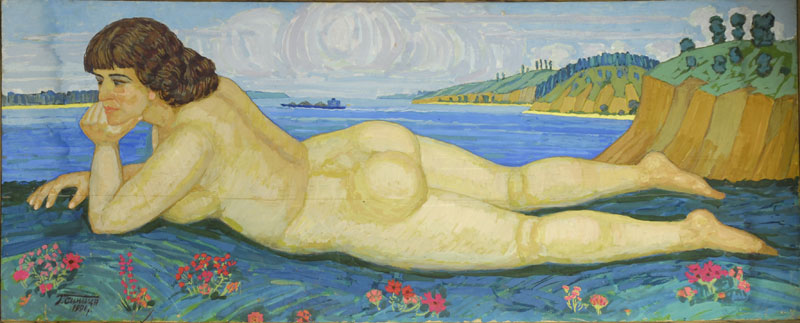
Grygoriy Synitsia did not renounce Boychuk's ideas, and sought to develop them creatively. For this purpose from the very beginning of the 60th years it works with gifted national artists, in particular, such as Maria and Feodor Priymachenko, Anna Sobachko-Shostak and Ivan Shostak (a national list), Anna Veres and Anna Vasilashchuk (weaving), Feodor Alekseenko (ceramics), Evmen Voylochny (stuffing) and Alexander Saenko (incrustation by straws). He helped them with creativity and at the same time studied their skill. Considering folk art as the primary source of color, composition, drawing, Grygoriy Synitsia in the creative commonwealth with national artists based the new direction in modern monumental the painting, received the name "Ukrainian Coloristic School". First of all, sign of this school is the respect of national culture of color as esthetic image, as maternal language, as national and historical the categories, testifying to belonging of the artist to the native earth, to the people.
In the middle and the end of the 60th years Grygoriy Inanovych imparts the knowledge and experience to young artists, the pupils, together with them creates a row of monumental ensembles, in particular, mosaic mural in Donetsk and Alexandria. Under the direction of the Synitsia worked A.Yakimenko, A.Gorska, G. Zubchenko, V.Zaretsky, G.Marchenko, L.Totsky, M. Shkaraputa. The next pupils and colleagues - Galina Zubchenko and Grygoriy Prishedko - in the seventies created in Kyiv the well-known mosaic compositions - "Victory" (X-ray radiology and oncology institute), "Smiths of the present" (Institute of nuclear researches), "Triumph of Cybernetics" (Cybernetics institute), "Movement" (sports palace of Academy of Sciences).
Grygoriy Synitsia endured revolution, the wars, two Famine-Genocide. He drove to Babi Yar too, it by miracle managed to escape. Therefore he devoted numerous number of the works to this tragedy. The year 1941 in Kyiv held his solo exhibition.
After the Great Patriotic War when to the country builders, instead of artists more were required, the working career of the Synitsia proceeds at Keramik plant of the city of Kyiv as the production supervisor where carried out tasks of restoration of Kyiv: facing by a terracotta Glavpochtamta, many houses on the Khreshchatyk, Chervonoarmiyska. By results of the performed works the Synitsia candidate then it was put forward on competition of the Stalin award, and then, without any explanations, it was refused.
At that time colleagues invited the artist to restoration of the Mariinsky palace. To the Synitsia many tried to execute difficult mouldings large-scale, more than three meters high, vases in Baroque style, but it turned out nothing. The method of manual molding developed by Grygoriy Inanovych at Keramik plant and for the first time is applied on restoration of the Mariinsky palace, brought success to the master.
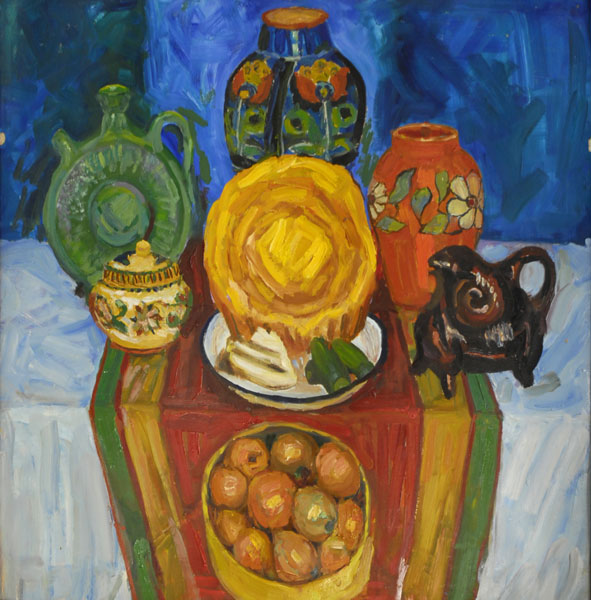
Because of charges of nationalism and continuous persecutions from the authorities in 1968 Grygoriy Synitsia was compelled to move to Kryvyi Rig where started working over new equipment "floromozayika" and developed, specially for this direction in creativity, unique glue. Tell that once on one of personal exhibitions huge work "Magicians" fell to a floor, and any element floromozayiki wasn't damaged and didn't fly away.
In total it was created 29 floromozayik, over each of which the artist worked from 2nd to 3 years. Also in Kryvyi Rig he finished fundamental theoretical and esthetically philosophical work "Colour in the Fine Arts".
In 1992 to Grygoriy Synitsia was awarded the State award of Ukraine of Taras Shevchenko - "for revival of the Ukrainian coloristic school of monumental painting and work of the last years". In 1996 he was awarded an honorary title "The deserved artist of Ukraine". On October 10 the same year as a result of a stroke he died.
As well as at many gifted artists, Grygoriy Inanovych's private life, unfortunately, didn't develop. in total he gave himself to art that any of his three wives couldn't accept and understand. And very few people from parents would like to see the husband of the daughter of the disabled person. The consequence of it is loneliness, lack of a family and, the main thing, children who could give a part of that at the end of the hard life to be sure that lived it not for nothing and that there are people who will keep its invaluable completions as heritage.
Grygoriy Synitsia was the person very modest. The certificate of it is his apartment in Kryvyi Rig, remained and until now. From it the museum which manager is his schoolgirl Elena Yakimenko was created. Probably, it would be fair to call her the foster daughter of the artist because she looked after him the last years, until the last second, to the last gasp. On walls of a museum it is proud pictures of the artist took place, don't allow to forget about indestructibly strong the personality who created them. And about devotion national, Ukrainian the embroidered shirts which Grygoriy Inanovych wore during lifetime testify. The old easel stands alone in the middle of the room, and on it - the latest work of the artist. Today, on January 17, 2008, Grygoriy Synitsia exactly 100 years would be executed.
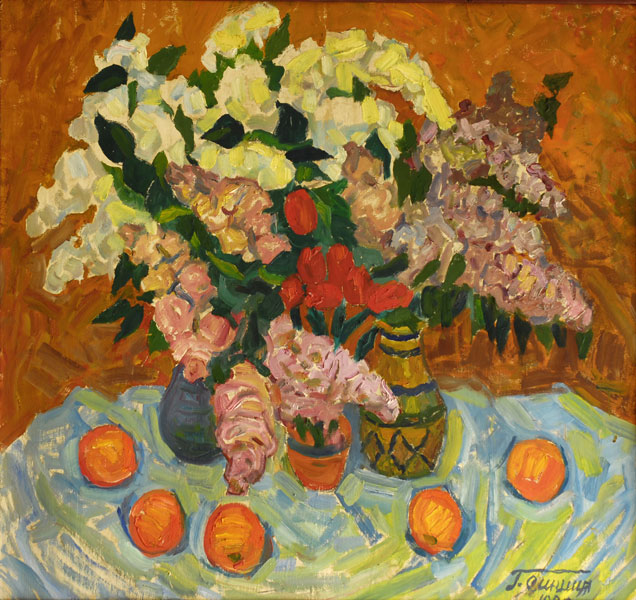
The NTUU "KPI" art gallery has honor to exhibit original works of the outstanding artist. As a sign of deep respect and honoring of his memory in February, 2008 in the Center of culture and arts the solemn holiday will take place. We invite all not indifferent to art to celebrate with us birthday of Grygoriy Synitsia, a prominent figure, the dedicated work I made an invaluable contribution to spiritual life of Ukraine.

